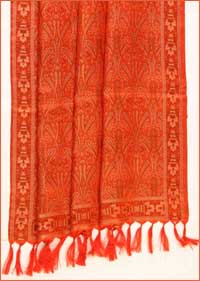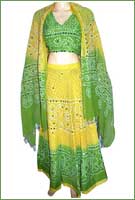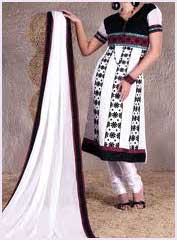
A dupatta is usually a long rectangular, scarf-like cloth which is worn over the shoulders by the women in India. It is generally cordinated with the traditional salwaar-kameez. The dupatta stands as a symbol of modesty in the Indian society. It is known by various traditional names like Odhni, Chunari, Chunni and even just Unni which is the name called by people of the Gujarati community. Duppata is manufactured in different fabrics, like cotton, silk, georgette, chiffon, and so on. Normally, it is worn keeping in mind the color combination of the salwar-kameez.
Dupatta can be used in various ways. Like it can be worn with ghagra choli, with one end of Dupatta tucked at the waistband of the ghagra (long-skirt). This kind of style is most often used by the Rajasthani women. Women are also known for using the dupatta on their head and both end of it flowing outwards. In modern times we also see its usage with jeans, sometimes as a sarong or turban or sash. In south India, a different nomenclature is used for dupatta worn over a low skirt. It's called as a half sari whereas in Assam it is called chaddar. In Gujarat, they call it chunri, whereas it is known as Dhathu in Himachal Pradesh. These dupattas or orhni or odhni comes in different texture of silk, cotton and chiffon. It also varies in length according to the region and culture of the place.
History
Going by the history normally we do not trace dupatta in ancient civilization. Even archaeological evidences of Mohenjadaro and Harappan civilization don't give us any proof of kind of garment. Vedic Indian people used to wear three garments; an under-garment called nivil, a garment known as vasas, and an overgarment known as adhivasa. Adhivasa was much similar to dupatta or can also be termed as chaddar of modern times used by both male and female to cover their upper parts. Gradually it developed on its own as Indian women became more aware of their modesty.
There are ample of ways by which one can don the dupatta. It is normally worn across the shoulders and women drape one end of it over their head, when in front of elders, as a sign of respect. Otherwise, when worn over a salwar suit you can wrap it around your neck even like a muffler also. Another style of wearing dupatta is to simply let it hang from one side of the shoulder. In the current fashion, it is frequently draped over one shoulder, with the other end is balanced in the crook of the other arm.
A duppata may be plain in a single hue, shaded, multi-hued or patterned. In some cases, when the dress is very simple, women glam it up by wearing a heavily embroidered dupatta over it. This is particularly done in case of a bridal dress. The dupatta of the bride is often very heavily embellished. In certain Indian states, like that of Bengal and Rajasthan, special type of tie and dye duppatas are available. The price ranges of these duppatas vary from 100 rupees to 1000 rupees.
Dupatta and its importance
The most interesting aspect of Indian family life is purdah (from the Hindi parda , literally meaning, curtain), or the veiling and seclusion of women. In much of northern and central India, particularly in rural areas, Hindu and Muslim women follow complex rules of veiling their body and avoidance of public appearance, especially in the presence of relatives linked by marriage and before strange men. Purdah practices are inextricably being linked to patterns of authority and harmony within the family. Rules of Hindu and Muslim purdah differ in certain key ways, but female modesty and decorum as well as concepts of family honor are essential to the various forms of purdah. In most areas, purdah restrictions are usually stronger for women of high-status families.

The importance of purdah is not limited to family life; rather, these practices all involve restrictions on female activity and access to power and the control of vital resources in a male-dominated society. Restriction and restraint for women in virtually every aspect of life are the basic essentials of purdah. In India, both males and females are circumscribed in their actions by economic disabilities, hierarchical rules of deference in kinship groups, castes, and the larger society. But for women who observe purdah, there are additional constraints.
For almost all women, modest dress and behavior are important. Clothing covering most of the body is common; only in tribal groups and among a few castes do women publicly bare their legs or upper bodies. In most of the northern part of India, traditionally dressed women cover the tops of their heads with the end of the sari or scarf (dupatta ). Generally, females are expected to associate only with kin or companions approved by their families and to remain sexually chaste. Women are not encouraged to roam about on pleasure junkets, but rather travel only for explicit family-sanctioned purposes. In contrast to females, males have much more freedom of movement and observe much less body modesty.
Through use of the end of the sari as a face veil and deference of manner, a married woman shows respect to her affinal kin who are older than or equal to her husband in age, as well as certain other relatives. She may speak to the women before whom she veils, but she usually does not converse with the men. Exceptions to this are her husband's younger brothers, before whom she may veil her face, but with whom she has a warm joking relationship involving verbal banter.
Initially almost faceless and voiceless in her marital home, a married woman matures and gradually relaxes some of these practices, especially as elder in-laws become senescent or die and she herself assumes senior status. In fact, after some years, a wife may neglect to veil her face in front of her husband when others are present and may even speak to her husband in public.

Such practices help shield women from unwanted male advances and control women's sexuality but also express relations within and between groups of kin. Feminine prestige, household harmony, social distance, affinal respect, property ownership, and local political power are all linked to purdah.
Restricting women to household endeavors rather than involving them in tasks in fields and markets is associated with prestige and high rank in northern India. There the wealthiest families employ servants to carry water from the well and to work in the fields alongside family males. Mature women of these families may make rare appearances in the fields to bring lunch to the family males working there and sometimes to supervise laborers. Thus elitism is expressed in women's exclusive domesticity, with men providing economic necessities for the family.
Only women of poor and low-ranking groups engage in heavy manual labor outside the home, especially for pay. Such women work long hours in the fields, on construction gangs, and at many other tasks, often veiling their faces as they work.
For Muslim women, purdah practices involve less emphasis on veiling from in-laws and more emphasis on protecting women from contact with strangers outside the sphere of kinship. Because Muslims often marry cousins, a woman's in-laws may also be her natal relatives, so veiling her face within the marital home is often inappropriate. Unlike Hindus, Muslim women do not veil from other women as do Hindus. Traditional Muslim women and even unmarried girls, however, often refrain from appearing in public, or if they do go out, they wear an all-covering garment known as a burka , with a full face covering. A burka which is a covered clothing protects a woman and her family from undue familiarity with unknown outsiders, thus emphasizing the unity of the family vis--vis the outside world.
Indian fashion dupatta is no more a traditional wear but has entered the arena of the fashion world. It is known by varied names like Chunni, Chunari and Odhni. Ideally it was attired by Indian women to bedeck their head while offering prayers in the temple. Even now, the women in rural areas cover their head with a chunaria as a symbol of respect towards elders. The best part of Dupatta is that you can wrap it around with almost every wardrobe whether classic ethnic style or trendy Indo- western. In fact ethnic outfits are absolutely incomplete without it.
Dupatta adds grace to the garment. They come up in all bright vibrant colors with beautiful beads and mirror work. When we talk about Dupattas, the first immediate thought that comes to mind is of Lal Dupattas of Rajasthan with elegant tie and die prints popularly known as Laharia. These Lal Dupattas look simply amazing especially on white colored suits.
Boutiques store Dupattas in various fabric types like cotton, silk and Chiffon, etc., with elaborate designs and prints. Dupatta draping styles have also undergone a major change. Draping style in itself pave way for a new fashion trend to thrive. One way is to wear it over both the shoulders with the middle portion covering chest. Other way is to attire it only on one shoulder. This style requires a proper neat folding of dupatta. The latest trend is to let your Dupatta cum stole hang around between your arms. So, just go about and flaunt your gorgeous looking Dupattas.


